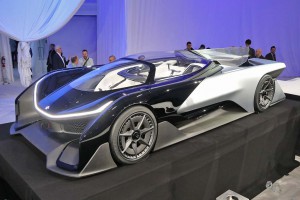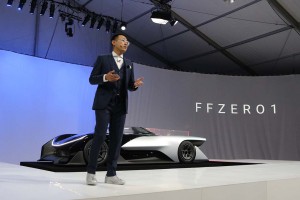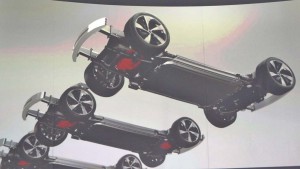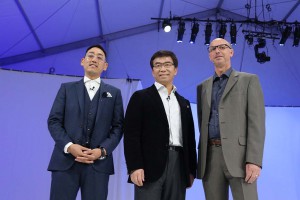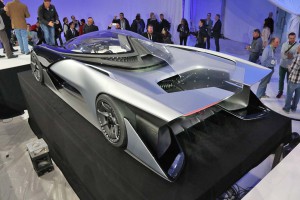A revolution on wheels? That’s what officials from Faraday Future laid out for an audience at the Consumer Electronics Show late Monday as the mysterious, Chinese-funded start-up carmaker finally came out from the shadows.
Launched just 18 months ago, largely with the backing of Chinese billionaire Jia Yueting, Faraday plans to set up a $1 billion assembly plant in North Las Vegas, with the first car set to roll down the line sometime in 2018, R&D chief Nick Sampson confirmed during a high-energy presentation. But the CES debut left plenty of questions unanswered.
Among them, what will Faraday build? The California-based carmaker rolled out the FF Zero1, something that lead designer Richard Kim called “a concept of cars,” but it is admittedly nothing more than an “electric dream car,” Kim stressed, rather than something likely to go into production.
That’s likely to remain a secret for some time, said Sampson during a media scrum. He did hint that Faraday will start out building something targeted at the premium end of the market and then move towards the mainstream. That’s much like rival EV maker Tesla Motors, for whom Sampson previously worked.
(CES turning into a high-tech car show. Click Here for more.)
Longer-term, the British-born engineer said, Faraday could build anything from a luxury car to an SUV, even a pickup truck using the new Variable Platform Architecture, or VPA, that it has developed. Looking a lot like an electrified skateboard – a concept one explored by General Motors – the VPA has tremendous flexibility in terms of its size and layout.
It can be fitted with anywhere from one to four electric motors, and it can deliver power to the front or rear wheels – or all four. The FF Zero1 concept vehicle has a wheelbase of 114.2 inches, 2.9 meters, Sampson told TheDetroitBureau.com, but that could shrink by as much 0.6 meters, or 23.6 inches, in part, depending upon how large a battery pack it is fitted with.
Even here, though, Faraday left things hazy, declining to say exactly what form of lithium batteries it will use or who will supply the cells. But Sampson said his company shares the fundamental strategy of Tesla, that it will require a lot of batteries to overcome so-called range anxiety among potential buyers.
During the hour-long presentation, Faraday officials outlined what they see as their competitive advantages. They noted they have assembled a team of 550 employees in California – Faraday operating out of the former Nissan offices in the Los Angeles suburb of Gardena – and 200 elsewhere. Many of them have been lured away from traditional automakers like Ford and BMW, as well as Tesla and high-tech firms like IBM and Apple.
They also stressed the speed with which the company has been operating. In just 18 months they have a running prototype and will soon break ground on the Nevada plant, which was partially funded by a $335 million incentive program from the State of Nevada.
And Faraday isn’t wedded to the traditional automotive model, officials kept repeating like a corporate mantra. An opening video asked whether it makes sense to “reinvent the same car industry we have today.”
“You don’t need to have a hundred year legacy in the automotive industry to define what the next generation of transportation needs to look and feel like,” Sampson said from the stage in front of the FF Zero1 concept.
But beyond the flexibility of the VPA platform, Faraday was vague on specifics about how it will otherwise change the automotive world.
Sampson and Kim noted that they plan to offer a high level of connected car features in Faraday’s future products. The FF Zero1 allows a motorist to plug their cellphone into the instrument panel so they can access all phone and cloud-based features, from navigation to contacts to music.
That would make it especially attractive to offer future models through carsharing services, Sampson suggested, rather than selling them. “You will feel familiar and comfortable with it,” even if it isn’t a car you actually own, he explained.
(GM gives ride-sharing company a $500 mil Lyft. Click Here for the story.)
The emphasis on connectivity isn’t surprising for several reasons. The industry, in general, is adding more such features. Ford and Toyota, for example, are showing off their own new infotainment and connectivity services at this year’s CES.
But there’s also the fact that Faraday’s lead investor, Chinese billionaire Jia, owns LETV, a company frequently compared to both Apple and Netflix. Faraday vehicles will plug into the network of services LETV provides, Sampson said.
“It’s an extreme tablet on wheels,” said designer Kim, of the FF Zero1 concept.
How much of a market there will be for the new company is far from certain. On the plus side, Tesla sold a record number of vehicles in 2015, delivering just over 50,000 of its Model S sedans and about 200 of the new Model X SUVs. But overall demand for electrified vehicles actually declined at a time when gas prices are cheaper than they have been in a decade.
Nonetheless, tough new emissions and fuel economy standards are expected to put momentum behind the shift to battery power, whether in hybrid, plug-in or pure battery-electric form. And there are plenty of opportunities abroad, as well. Indeed, China is pressing the auto industry hard to shift to batteries as it struggles to address endemic air pollution issues.
Could Faraday find its future selling abroad, especially in China? That’s another one of the questions the new company isn’t ready to answer.
(Ford and Google deal to go beyond autonomous vehicles. For more, Click Here.)

